Championships
Introduction
The historian Iztueta tells of the time when he was called to judge a bertsolari contest. Gorosabel says that, "the desire of the verse-singers to prevail at this skill is such that, on many occasions, there were challenges and competitions with rules agreed to in public squares, given the immense number of betting spectators, and with the winner receiving considerable sums for their efforts." That is to say, there have always been "championships", some with rules of some kind or other. Given that betting has existed in athletics and sport, the bertso is no more than a continuation of rivalry, at times to mock the loser and, at others, to extract revenge from the victor. Many compositions about pelota, Basque handball, are witness to this.
The pre-war championships (1935-1936)
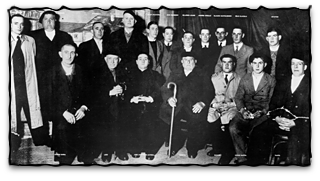
There are three, clearly defined, periods in the history of the Bertsolari National Championships: the pre-war championships, those organised by the Euskaltzaindia (The Basque Academy of Language and Letters), and the contests organised by the bertsolaris' association known as the Bertsozale Elkartea.
Organised by the Euskaltzaleak association and the Basque nationalist youth organisation, Eusko Gaztedi, whose members transcribed the bertsos sung in the championships held in 1935 and 1936 in the Poxpolin and Victoria Eugenia theatres in Donostia-San Sebastián. 20 bertsolaris from all over Euskal Herria attended the first, where no preliminary heats took place. Amongst them was Ignazio Eizmendi, Basarri, a regular columnist with the daily newspaper, Euzkadi. He was the literate bertsolari of the time and of great value to Basque nationalism. He was the first champion.
During the second championship some 30 bertsolaris competed for the 10 places in the final. One of them was a regular of those dens of iniquity, a rustic Bohemian and a genius of improvisation, Jose Manuel Lujanbio, known as Txirrita, from Hernani, and who was relegated in the first championship. Txirrita was the link to the XIX century bertsolari, he had heard Xenpelar singing, he had competed with Pello Errota and Otaño, and he had been some sixty years drinking and singing from town to village and publishing satirical ballad sheets of rare elegance and exquisite form. He was a living legend and, despite representing the antithesis of the model which the organisers were trying to present, they could not deny him his merit. Beginning to age, built like a tank, unable to read or write, he was simply a rural genius before the public. He was voted champion.
The championships organised by Euskaltzaindia (1960-1982)
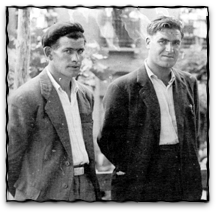
The post-war period lasted more than twenty years before the Euskaltzaindia managed to get authorisation to organise a bertsolari championship in 1960. In the eliminatory heats, 56 extempore singers took part and ten of these ad-libbed their way to the final judgement which went in favour of Basarri, his second time as champion.
The championships of 1962, 1965 and 1967 gave Manuel Olaizola, Uztapide, the accolades. Uztapide had taken part in the 1936 championship and had shared the same fate as Basarri in the Francoist hard labour camps. They were the pair who maintained the bertsolaritza tradition in public during the harsh 40's and 50's. But they kept the spirit going so that future bertsolaris could carry on and, indeed, little by little, they saw their art being taken on by new generations.
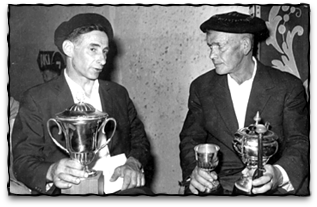
In the championship of 1967, nevertheless, a serious incident was to leave its mark on the world of the bertso: when Xalbador was declared a finalist, a constant booing of some five minutes prevented him from singing his final contribution. Xalbador was of the lyrical tradition of bertsolaritza and sang somewhat coldly but with profound meaning. Add to this the fact that his renditions were in the Lower Navarre dialect, difficult for the unschooled Gipuzkoan public of the time (the standardised Basque, Batua, had not yet made inroads), he was not one of the "popular" tradition. There were also small-minded interests who had supported others who had not been classified. When, at last Xalbador made himself heard, he was able to keep his head about him, singing a bertso which is historic today, as are many of his others. He was hardly allowed to finish but this time because of the loud and long applause from the public. This incident profoundly influenced bertsolaris. It was another thirteen years before the next championship.
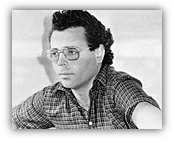
The 1980 and 1982 championships meant an important renovation in bertsolaritza, being blessed with the presence of Xabier Amuriza. Ex-priest and ex-political prisoner, Amuriza represented a generation strongly committed to the cause of national freedom as well as socially. During more than six years of captivity, he had studied, written and been published. It was known, through the bertso-paperak that he had composed in jail and which were passed from hand to hand, Amuriza, on paper at least, was an extraordinary bertsolari. In 1980 he showed that he could also improvise ("Gizona ez da ogiz bakarrik bizi", X. Amuriza). Absorbing all the culture of past bertsolaritza and open to the influences of modern poetry, he renewed the image, introduced metaphor, provided new melodies and demonstrated that the standardised Basque language, Batua, lent itself equally well to improvisation as any dialect had done before. Collector, researcher, pedagogue, writer, Xabier Amuriza is the model to which many of today's bertsolaris look.
The championships organised by Bertsozale Elkartea (1986-...)
Important differences in criteria concerning the organisation of the championships gave rise to serious problems between the bertsolaris and the Euskalzaindia, the Academy of Letters. The bertsolaris, supported by a group of aficionados, decided to organise the 1986 championships off their own back. This decision was the genesis of the Bertsozale Elkartea, our association.
On average, some 100 bertsolaris have taken part in these championships. Given that not all repeat their participation, the figure is a sign of very good health. The other important figure is that relating to the number of spectators. All the championships organised by the Association have been held at the indoor cycle track, the velodrome at Anoeta in the city of Donostia-San Sebastian and always filled to overflowing, indicating the level of popularity enjoyed by the championship.
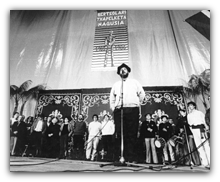
Sebastian Lizaso, the 1986 champion, is a genius of ironic dialectic, of rapid and sharp thinking. Unbeatable in debate, Lizaso is the privileged heir of the historic bards, Txirrita and Pello Errota.
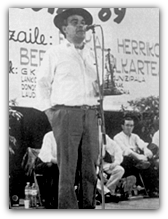
Jon Lopategi, 1989 champion, is a long-standing bertsolari who rose to fame during Franco's dictatorship and was, thus, persecuted. A true representative of the Bizkaian tradition formed around the Enbeita family, his bertsos have always been a combination of commitment and elegance.
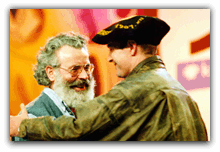
Andoni Egaña, champion in 1993, 1997, 2001 and 2005, attracted to bertsolaritza by the example set by Amuriza, has been able to create a personal style which is delicate in its form, profound in its thinking, literate in its expression and ironic in its humour. He is the image to which many young bertsolaris look.
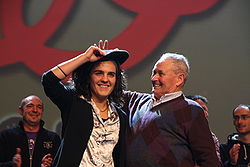
In 2009, Maialen Lujanbio won the National Championship of Bertsolaris

In 2013, Amets Arzallus won the National Championship of Bertsolaris.
Champions
|
Year
|
Place
|
Champion
|
|---|---|---|
|
Donostia
|
||
|
Donostia
|
||
|
Donostia
|
||
|
Donostia
|
||
|
Donostia
|
||
|
Donostia
|
||
|
Donostia
|
||
|
Donostia
|
||
|
Donostia
|
||
|
Donostia
|
||
|
Donostia
|
||
|
Donostia
|
||
|
Donostia
|
||
|
Barakaldo
|
||
|
Barakaldo
|
||
|
Barakaldo
|
||
|
Barakaldo
|
-----------------------------------------
See also: